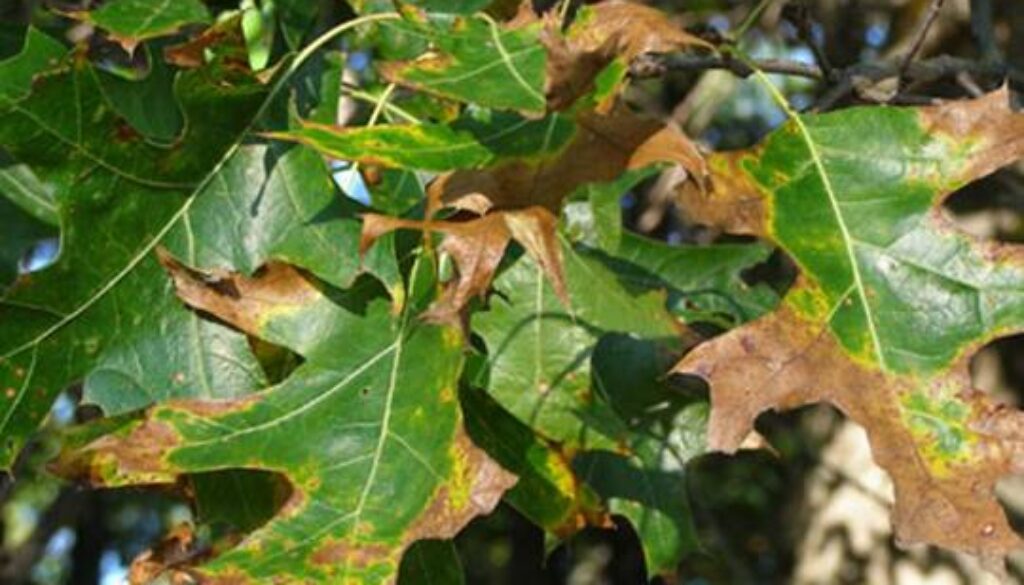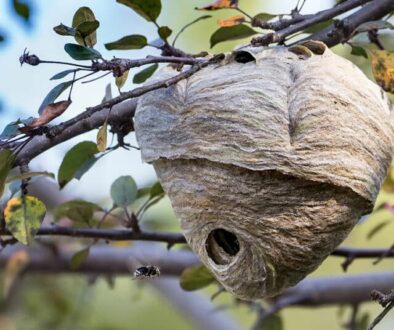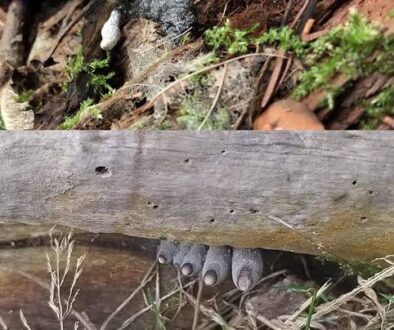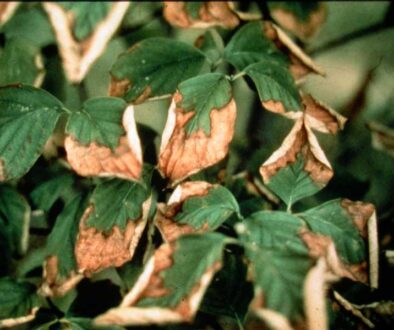Oak Wilt Disease
Oak Wilt Disease
The Evolution and Spread of Oak Wilt Disease
Oak Wilt is a devastating tree disease that has infected North American forests since the beginning of the 1900s. The origin of the disease is unknown. It was first observed in the Upper Midwest, but there are theories that it may have moved into the United States from Mexico or further South. It is probable that the encouragement of Oak varieties as the predominant forest wood due to deforestation of the coniferous forest and fire suppression as the population of the Midwest grew led to the spread Since it was first described in a tree in Wisconsin, this rapidly spreading disease has been reported throughout the Midwest and Texas. While it is currently only a threat to most varieties of oak in North America, its persistence and the lack of resistance to its effects in oak trees means that it is a serious threat to oak varieties worldwide.
Trees can contract Oak wilt in a few different ways. Although the spores can fly through the air as particles, insects, small animals, and birds are the main carriers of the spores. They spread the spores to uninfected trees as they carry them on their bodies. Unless the spores are introduced by a broken or trimmed limb or any other lesion on the tree, they do not infect the tree. The illness spreads quickly once it is introduced and can destroy the tree in as little as six weeks.
The disease spreads not only by insects and other vectors but also by root grafts, which it uses to infect neighboring oak trees. The roots of oak trees are very widespread. These root systems frequently come together. Oak trees frequently experience grafting between their roots as a result of unique cells in their roots being compressed and joined, a process known as inosculation. Trees close to one another can exchange nutrients and information because of this process. By using this networked vascular system, the oak wilt fungus’s spores can spread to adjacent trees and cause many tree deaths from a single infection. An infected group’s root network can retain and spread the illness for many years.
The primary cause of death is a result of the spores’ function in conjunction with the tree’s response to the infection. The fungus spores increase until they obstruct the plant’s vascular system. The tree’s defensive mechanisms produce a significant amount of gums and tylose in response to the illness. These are made to compartmentalize the infection, but in the end, they obstruct the passage of nutrients and water. When the two processes come together, the vascular system collapses and the tree dies.
Symptoms of Oak Wilt Tree Disease
The tree’s leaves drooping, browning, and dropping in the early to late summer is the first sign of an oak wilt fungal infection. Starting with the defoliation of the tree’s crown, this process will proceed down the tree to its base. These leaves won’t fall entirely bare like typical leaves do. When leaves are infected, they frequently have a dull green to golden appearance and, if they are still dark green, sometimes look wet from water. Since this first symptom resembles those of other oak tree diseases, you should search for further subtle indications of the illness.
The tree will experience dieback as the disease worsens, starting at the crown and moving downhill. The infection in red oak trees results in the formation of a fungal mat beneath the bark. The white mat has an oval shape and darkens with age to give the appearance of a bullseye. Eventually, as the mat grows and spreads beneath the bark, pressure is applied, causing the bark to bulge and eventually break. This break will release a very peculiar fragrance that has been likened to fermenting fruit. Only in red oak trees does this latter stage take place.
Varied Symptoms For Oak Types
While the symptoms for oak wilt are generally similar, each major variety of oak has its own set of peculiarities:
- RED OAK: Red oak trees are the most vulnerable to oak wilt.
- The symptoms of this tree disease are less conspicuous at first. For instance, while the leaves will turn brown they do not drop but rather remain connected. This results in a symptom referred to as flagging where the tree will resemble its normal autumn appearance in the middle of summer.
- Red oak trees are not only more likely to develop this infection, they die the most quickly of any of the varieties of oak. The process from infection to death is normally 6-8 weeks.
- Red oaks are also more likely to create root grafts with other oak trees, allowing the disease to spread more easily to other oak trees in the stand.
- Red oak trees never survive an infection of oak wilt.
- LIVE (EVERGREEN) OAK: This variety of oak can withstand the infection longer, but will eventually succumb to the disease.
- Most live (or evergreen) oak trees will defoliate and die within 3-6 months of the initial infection.
- A live oak can remain in various stages of decline over many years before finally succumbing to the disease.
- There have also been examples of live oaks surviving the decimation of a stand of oak trees without becoming infected.
- A symptom that is unique to the live oak is referred to as “veinal necrosis”, where the veins of its leaves turn yellow and then brown. The remainder of the leaf begins to turn as the brown spreads from the vein. Sometimes the vein of the leaf will appear to turn a deeper green than the rest of the leaf in a process called “vein banding”. Tip burn (sometimes called margin burn) which turns the edges of the leaf brown can also be observed.
- WHITE OAK: White oaks are the most robust of the oak species about oak wilt.
- Most white oak trees exhibit some canopy loss from this tree disease.
- White oaks are least likely to spread the infection as they are not able to support the development of the fungal mat and are less likely to develop root networks through grafting.
- The progression of the effects of the infection will occur from the crown downwards, but will often be isolated to one branch or occur irregularly through the tree. This variety of oak is more likely than the others to ultimately survive the infection, although they will lose some branches to it.
It is crucial to remember that Oak wilt is a dangerous and contagious disease that affects trees. It is relative to say that White Oak trees have a higher chance of surviving this virus. Many white Oaks die from Oak wilt and some of them die quickly. Furthermore, just because a certain type has a lower propensity to spread the virus does not guarantee that it won’t.
Remediation of Oak Wilt
Unlike some other tree diseases, Oak wilt has more than a limited chance of success. In most cases, the tree will die. In some cases, the tree will be dramatically impacted. In rare cases, the tree will survive without contracting the infection while the entire stand around it dies. The best course of action in most cases is to remove the infected tree, preferably during the winter months to significantly reduce the possibility of spread to surrounding trees.
If you have a tree infected by oak wilt you can attempt to reduce the possibility of spread through root grafts by trenching around the tree. This is not guaranteed to stop the spread through the roots, as the root grafting may be deeper than your trench. Normally a trench of four feet in depth that surrounds the infected tree is recommended. Additionally, the trenching should be done as quickly as possible after the initial symptoms of the infection are seen, as there is a delay in the initial infection and the display of symptoms.
Fungicidal treatment has some limited success in treating Oak wilt disease in the early stages for certain varieties of oak. It does not stop root transmission, so it should be done in conjunction with trenching. In most cases, fungicide injections will be ineffective for trees already exhibiting symptoms of the disease. However, it can be effective in preventing the spread of the infection to and in non-symptomatic trees.
Prevention of Oak Wilt Tree Disease
The following are steps for preventing this devastating tree disease.
- Do not prune oak trees between April – September unless necessary. If you prune an oak during this period use pruning paint immediately after the cut. Sap-feeding beetles can find these cuts within a half-hour and can transmit the spores immediately.
- Prune broken branches on oak trees as soon as possible, if trimming in the off-season treat the cut immediately with fungicide and pruning paint.
- Sterilize all pruning equipment between trees.
- Diversify your trees as much as possible to prevent a single disease from killing all of the trees on your property. Additionally, plant trees that are native to your area to not introduce exotic diseases. This will also provide a sustainable habitat for local birds and wildlife.
- If you have an Oak tree that is considered to be high-value, you should treat the Oak tree with fungicide by a certified arborist, like Johnson Ops Tree Care.
Call Us Today! 608 526-6297
When you see symptoms, it’s important to contact a Certified Arborist right away, as is the case with any tree ailments. The sooner the certified tree expert assesses the problem and develops a plan of action, the better chance the tree has for survival.




